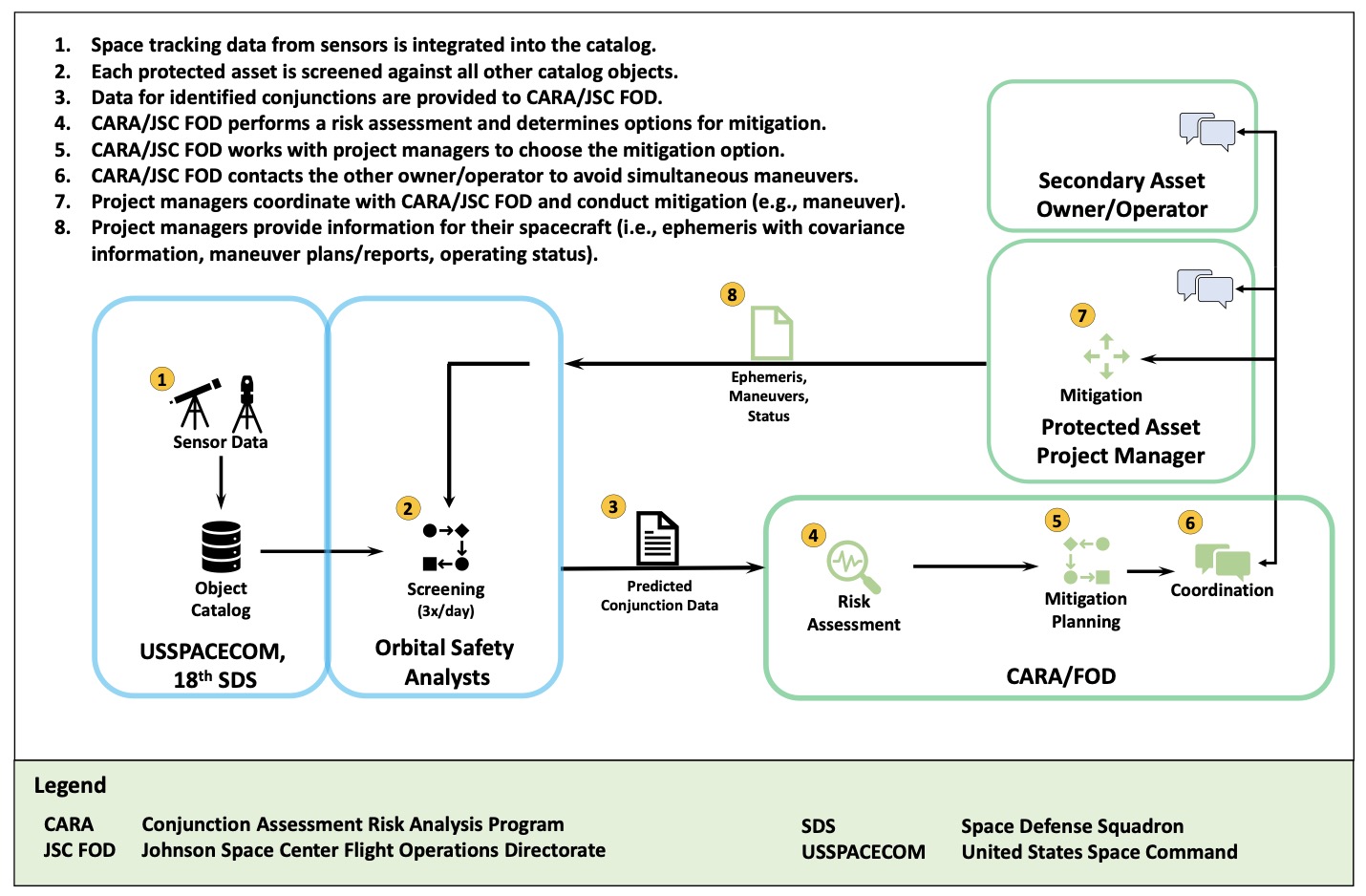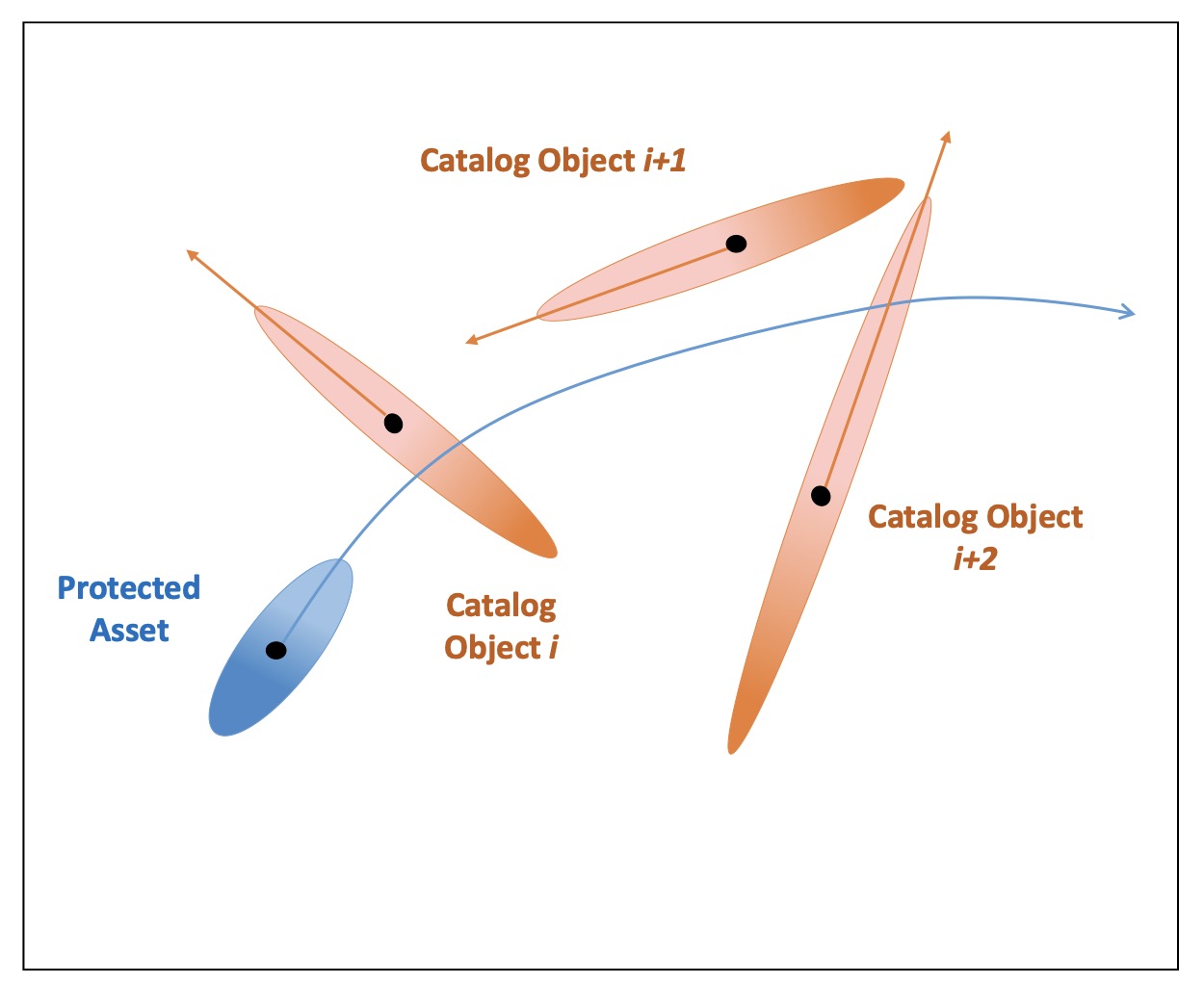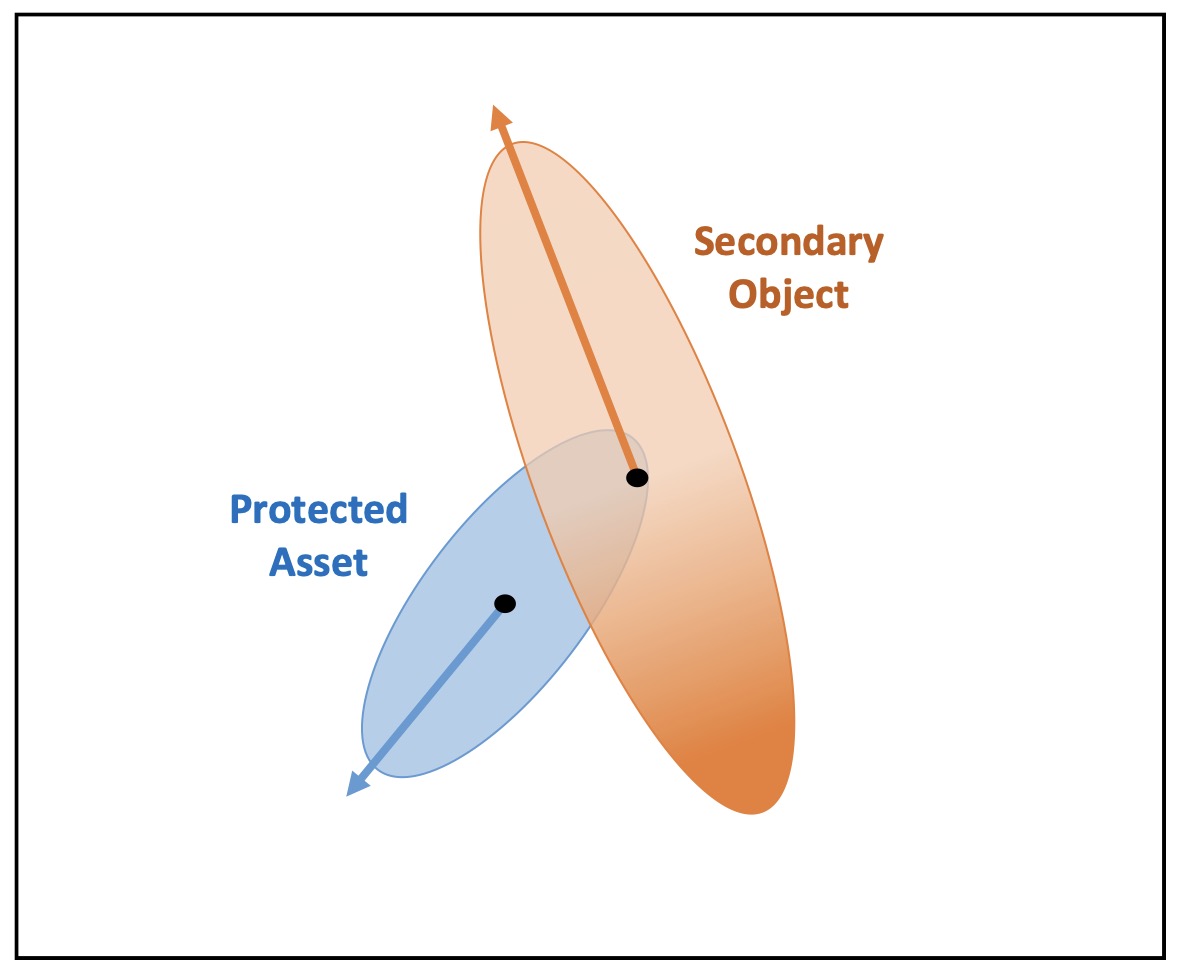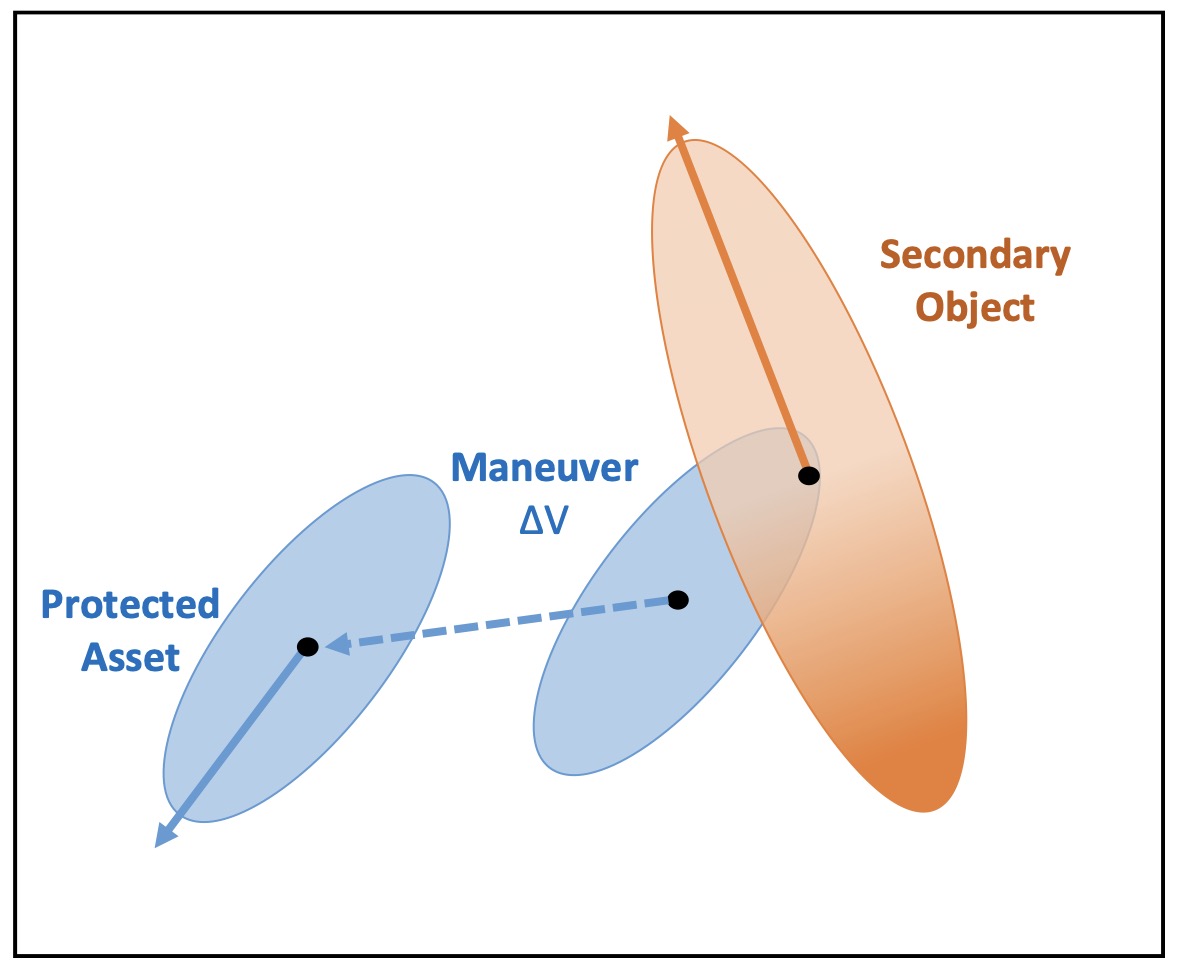
Procedural
Requirements
Effective Date: June 27, 2023
Expiration Date: June 27, 2028

|
NASA Procedural Requirements |
NPR 8079.1 Effective Date: June 27, 2023 Expiration Date: June 27, 2028 |
| | TOC | Preface | Chapter1 | Chapter2 | Chapter3 | Chapter4 | Chapter5 | AppendixA | AppendixB | AppendixC | AppendixD | AppendixE | AppendixF | ALL | |
1.1.1 As more spacecraft are deployed, the space environment becomes increasingly congested. Therefore, it is important for spacecraft operators to coordinate planning and operations to lower the risk of spacecraft collisions, not only to protect the assets involved but also the space environment. A framework of standard practices facilitates appropriate protocols between spacecraft operators.
1.1.2 Current United States (U.S.) and international laws and regulations affect many elements of a NASA space flight project including launch and return to Earth, operations, communications, use of certain sensors or technologies, disposal, and demise. Additional legal or regulatory requirements are expected, particularly in the areas pertinent to this directive. NASA project managers may need to demonstrate compliance with such laws and regulations and to provide direction to partners or service providers. In the event of a conflict with this directive, laws or regulations take precedence.
1.1.3 NASA's interests are best served by proactively implementing protocols and best practices to reduce collision risk. NASA supports other Federal agencies in their development of regulations and policies for protecting the space environment. NASA actively participates in raising awareness of space environment concerns, mentoring spacecraft operators in establishing effective practices, and developing baselines, standards, and best practices.
1.1.4 This directive establishes minimum orbit and trajectory protocols and associated operational requirements for NASA to protect the space environment and manage the risk of collision between a NASA-owned or -operated spacecraft and other man-made objects. Some of these measures are implemented during conceptual and design phases while others can only be fully implemented during operations.
1.1.5 For conjunction assessment and mitigation, the focus of applicability is spacecraft operations between separation from the launch vehicle (or other deployment) and spacecraft disposal. This directive applies to space flight programs and projects that:
a. Operate spacecraft in any Earth orbit that exceeds 130 km (~80 miles) in altitude, including for short timeframes such as phasing loop orbits.
b. Operate spacecraft in orbit about the Moon, Mars, or any other solar system central body orbited by more than one spacecraft.
c. Operate spacecraft in orbit about a Sun-Earth or Earth-Moon Lagrange point orbited by more than one spacecraft.
d. Perform a fly-by of Earth or any natural body orbited by other spacecraft.
1.1.6 To avoid collisions, predicted trajectory data are collected and actively processed to continuously assess potential close approaches between space objects. Spacecraft, subsidiary deployed objects, and jettisoned objects are tracked, and to this end, program and project managers are responsible for making their products trackable. (See Section 3.1.2.)
1.1.7 To quantify the likelihood of a collision, a conjunction risk assessment considers uncertainty from many sources, including environmental conditions such as upper atmospheric drag and available sensor data quality. Spacecraft operators use the assessment to determine whether to initiate mitigating actions such as a maneuver. Mature practices in this area and active coordination among independent spacecraft operators result in a safer space environment for all operators.
1.1.8 An example of an Earth-orbiting collision avoidance process for a NASA-owned or -operated spacecraft is depicted in Figure 1-1.

Figure 1-1 Earth-Orbiting Collision Avoidance Process for a NASA-Owned or -Operated Spacecraft
1.2.1 Conjunction analysis and mitigation activities are performed throughout the project life-cycle. In the design phase, project managers pay attention to the requirements in this directive for mitigating the potential for collisions to prevent costly redesigns later or unnecessary operational challenges after launch. Reducing the potential for spacecraft collisions continues with on-going monitoring and risk assessments after launch.
1.2.2 Early Phase Planning, Development, and Testing
During concept development, project managers consider how to make their spacecraft trackable, which orbits or trajectories will minimize the likelihood of collisions, and whether the spacecraft needs maneuverability to avoid potential collisions. Conjunction analysis and mitigation capabilities depend on spacecraft architecture and design. As designs are developed and reviewed, project teams consult with Agency subject matter experts available in the NASA Conjunction Assessment Risk Analysis (CARA) Program, the Johnson Space Center (JSC) Flight Operations Directorate (FOD), and the Space Operations Mission Directorate (SOMD) Launch Services Office (LSO) on the capabilities needed for spacecraft tracking and collision mitigation. Tracking and mitigation capabilities can be tested, verified, and validated during the later stages of development. (See Chapter 3 of this document for additional detail on pre-launch activities and key products.)
1.2.3 On-Orbit Conjunction Analysis and Mitigation Process
1.2.3.1 After launch, NASA implements a three-step conjunction analysis and mitigation process: conjunction assessment, conjunction risk assessment, and conjunction mitigation. (See Chapter 4 of this document for additional detail on the three steps of the conjunction analysis and mitigation process.)
a. Conjunction assessment (otherwise referred to as "screening") compares trajectory data from the "protected asset" (otherwise referred to as the "primary object") against the trajectories of the objects in the applicable database.
(1) For Earth orbiting objects, screening is performed against the space object catalog maintained by the United States Space Command (USSPACECOM) to predict when a close approach will occur within a volume of space called a "safety volume" placed about the asset. This catalog includes information about international and commercial operational spacecraft as well as all trackable debris. (See Figure 1-2 for an example of the conjunction geometry for a near Earth-orbiting spacecraft with covariances indicated as ellipses.)
(2) For non-Earth orbiting objects, the ephemeris of the protected asset is only screened against other provided ephemerides.

Figure 1-2 Conjunction Assessment
b. Conjunction (i.e., "close approach") risk assessment determines the likelihood of two space objects colliding and the expected consequence if they collide in terms of lost spacecraft and expected debris production. (See Figure 1-3.)

Figure 1-3 Conjunction Risk Assessment
c. Conjunction mitigation remediates conjunction risk. Potential actions include changes to the trajectory such as those resulting from a propulsive maneuver (Figure 1-4); an attitude adjustment (e.g., for differential drag or to minimize frontal area); or providing ephemeris data to the owner/operator(s) (O/O) of the secondary (other) object in the close-approach event to enable that spacecraft to plan and execute an avoidance maneuver.

Figure 1-4 Conjunction Mitigation
1.2.3.2 Each spacecraft is independently considered in the on-orbit conjunction analysis and mitigation process. When two NASA spacecraft experience a conjunction with each other, each will receive a separate analysis identifying them as the protected asset. In some cases, a non-NASA spacecraft may be analyzed as the primary or protected asset and the NASA asset is the secondary object.
1.3.1 This directive requires two key products to support the conjunction analysis and mitigation process:
a. The Orbital Collision Avoidance Plan (OCAP) documents the results of study and analysis tasks and design considerations. The project manager implements this plan while preparing for operations. (See Chapter 3 and Appendix D.)
b. The Conjunction Assessment Operations Implementation Agreement (CAOIA) documents specific operational processes the project implements to protect the spacecraft and space environment. (See Chapter 3.)
1.3.2 Programs and projects should reach out to CARA or JSC FOD as soon as possible (after approval and prior to Mission Concept Review (MCR)) to begin working on the draft OCAP and CAOIA.
1.4.1 Overview
1.4.1.1 Two groups at NASA coordinate close-approach topics for NASA space flight missions: CARA for non-human space flight (non-HSF) missions and JSC FOD for human space flight (HSF) missions with or without crew. For data and support required for conjunction assessment and risk analysis, NASA uses CARA and JSC FOD (specifically at JSC FOD, the trajectory operations officer (TOPO) and flight dynamics officer (FDO) positions) as the exclusive interfaces to the U S. Space Force's 18th Space Defense Squadron (18 SDS) and USSPACECOM.
1.4.1.2 In addition, LSO supports conjunction mitigation by managing review of license requests and ensuring flight safety. LSO communicates NASA's interests and concerns to regulating agencies and Agency partners in its capacity as NASA's representative to the Commercial Space Transportation Interagency Group, which was established pursuant to Executive Order 12465, Commercial Expendable Launch Vehicle Activities. In collaboration with the NASA Office of International and Interagency Relations (OIIR), LSO also coordinates communication of rules, regulations, and requests for license review through the NASA community for awareness and comment.
1.4.1.3 For Earth-orbiting spacecraft, collision avoidance relies on data from several sources. When data for conjunction assessment and space situational awareness (SSA)-related communication need to be obtained from the U.S. Department of Defense (DOD), orbital data request (ODR) forms are submitted to 18 SDS. The current version of the ODR forms can be obtained from CARA or JSC FOD. For NASA space flight missions, these forms need to be submitted to 18 SDS by CARA or JSC FOD to comply with the official Memorandum of Agreement (MOA) between DOD and NASA, which specifically restricts access. Managing the interface with DOD requires personnel trained and familiar with DOD's specific handling and data schemata to avoid data handling errors.
1.4.1.4 For non-Earth orbiting spacecraft (currently Moon, Mars, or Sun/Earth Lagrange points 1 [L1] or 2 [L2]), collision avoidance relies primarily on spacecraft ephemerides prepared by spacecraft navigation teams using a tracking network. These ephemerides are generally accurate for conjunction assessment for a few weeks. Thus, a regular ephemeris update process needs to be negotiated between the project and the project's tracking network. In some cases, particularly those that involve a non-NASA U.S. Government or foreign government tracking network, the NASA OIIR may need to facilitate the periodic ephemeris exchange process.
1.4.2 NASA's Conjunction Assessment Risk Analysis Program
1.4.2.1 CARA is an Agency-level resource that provides support to all NASA non-HSF missions. CARA protects the orbital environment from collision between NASA non-HSF missions and other tracked on-orbit objects.
1.4.2.2 CARA routinely collects predicted orbital information from NASA space flight projects, passes it on to 18 SDS for screening, analyzes the screening results to determine the risk posed by predicted close approaches, and works with NASA space flight projects to determine an appropriate mitigation strategy for the close approach risk.
1.4.2.3 CARA is the sole entity with authority to submit ODRs to DOD on behalf of NASA non-HSF missions both to ensure compliance with the NASA-DOD MOA and to permit standardization of requests across NASA.
1.4.3 JSC Flight Operations Directorate
1.4.3.1 JSC FOD provides conjunction assessment support to NASA HSF missions through two console positions (TOPO and FDO) staffed by SOMD. These positions assist NASA HSF project managers in monitoring and identifying potential conjunctions and developing possible maneuvers to avoid conjunctions.
1.4.3.2 Because the conjunction assessment support is integrated with the space flight mission operations for HSF, the process is documented as part of policies and procedures for HSF programs and projects. JSC FOD will implement the operational requirements found in chapters 4 and 5 of this directive by capturing the requirements in HSF mission flight rules or jettison policy documentation.
1.4.3.3 JSC FOD is the sole entity with authority to submit ODRs to DOD on behalf of NASA HSF missions both to ensure compliance with the NASA-DOD MOA and to permit standardization of requests across NASA.
1.4.4 NASA SOMD Launch Services Office
1.4.4.1 The LSO representative reviews launch license requests (i.e., for a launch license, reentry license, experimental permit, payload review, launch operator license, or launch site operator license) that have been submitted to LSO by the Federal Aviation Administration (FAA), the Federal Communications Commission (FCC), or the National Oceanic and Atmospheric Administration (NOAA).
1.4.4.2 Based on the information documented in the launch license request, the LSO representative forwards the request to appropriate contacts within NASA to determine whether there is risk to NASA asset health or safety.
1.4.4.3 The LSO representative consults NASA organizations including CARA and JSC FOD, the Office of Safety and Mission Assurance (OSMA), the Science Mission Directorate (SMD), and the International Space Station (ISS) Program to capture license review feedback.
1.4.4.4 LSO provides the NASA responses, including questions and concerns, back to the requesting agency and coordinates any related discussions. If major concerns are identified, LSO works to connect the NASA technical team with the license applicant to aid in a resolution.
| TOC | Preface | Chapter1 | Chapter2 | Chapter3 | Chapter4 | Chapter5 | AppendixA | AppendixB | AppendixC | AppendixD | AppendixE | AppendixF | ALL | |
| | NODIS Library | Program Management(8000s) | Search | |
This document does not bind the public, except as authorized by law or as incorporated into a contract. This document is uncontrolled when printed. Check the NASA Online Directives Information System (NODIS) Library to verify that this is the correct version before use: https://nodis3.gsfc.nasa.gov.